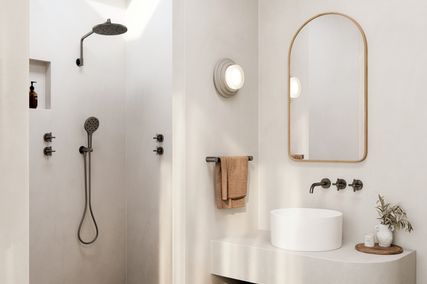Is anyone interested in talking about feminism and architecture anymore? Niki Kalms and Hélène Frichot reflect on issues raised at a recent roundtable discussion.
Is anyone interested in talking about feminism and architecture? In early December 2007 we convened an informal roundtable at RMIT dedicated to past and present conjunctions of feminism and architecture, in partial response to a question from visiting Swedish architect and scholar Katja Grillner. To many, the coupling of architecture and feminism might seem anachronistic now, a defunct double act in an era in which surely we have transcended the necessity to highlight “women’s issues” – for instance, equality of pay, political representation and expression. But curiously, as our small event was being organized, other similar forums and events also emerged from the political woodwork. Gertrude Street Contemporary Art Spaces held a forum provocatively entitled Feminism Never Happened a couple of weeks prior, while earlier in the year the Brooklyn Museum, New York, hosted a show called Global Feminisms (21 March – 1 July 2007), which gathered together a selection of artists grappling with feminist issues from the 1990s to the present day. Those who participated in the RMIT roundtable speculated on whether such signs might tentatively suggest a return to questions and projects that fall loosely under the much-maligned and misunderstood rubric “feminism”.
Feminism as a project concerns both sociopolitical issues and intellectual or cultural projects. The plurality of feminisms that can be historically traced, at least from the French revolutionary period onward, make feminism seem a cacophonous area of practice and research. For convenience, feminism is often arranged into “waves” that seek to organize relevant activities around particular historical periods. According to this arrangement, first-wave feminism seeks women’s emancipation from the yoke of the private domestic realm so they can enter into the same political field as men and be recognized as political actors with equal rights. Second-wave feminism is more often associated with intellectual and cultural projects. Although it emerged alongside the student and workers’ protest movements of the late 1960s and continues to call for the formulation of women’s rights, it also began to develop a distinctly feminine voice that allows the celebration of sexual difference. A third wave can also be identified developing from the 1990s on, which questions a reliance on essential definitions of what constitutes woman. The third wave opens up to the voice of the dispossessed “other” in the form of post-colonial and ethnic identities, queer expression and all the minor voices that a micro-politics calls forth. Importantly, with respect to all of the above, feminism is not necessarily just for women. Anoma Pieris of the University of Melbourne spoke at the roundtable about the feminization of former colonies, and how fledgling independent nation-states can come to be gendered to their disadvantage. This is also a reminder that while women in post-industrial nations may feel that the feminist cause is no longer relevant, this is a very privileged stance when placed in counterpoint to the plight of women in many developing countries.
Despite the convenience of arranging feminisms into “waves” of action, we have to be wary of framing distinct periods for, as Karen Burns pointed out, we risk forgetting the ongoing, if quiet, efforts of women and others to have their voices heard. It is important to recognize the continuities as well as the ruptures in the multifarious threads that constitute feminist histories. Our contemporary stress on innovation often involved forgetting what has been achieved, or the subtle erasure of knowledge gained. (Burns described an example of this as “intergenerational matricide”.) Karen Burns and Harriet Edquist noted that it has been some twenty years since they coedited an edition of the journal Transition, dedicated to architecture and feminism. Edquist also recalled an active architectural women’s group that used to convene in the late eighties and early nineties named after Eileen Grey’s House, E.1027. The importance of a collective voice was emphasized by many gathered at the Architecture and Feminism Roundtable, and it was suggested that the focus on individual architects constitutes an insufficient account of the current activity of women operating in the field of architecture.
In terms of contemporary expression, a confusing trend has developed where, through a desire to emancipate the female body and its diverse modes of sexual expression, women have come perilously close to returning their bodies to the status of mere objects of desire. What is known as “raunch culture”, in which it is considered daring to foreground women’s sexuality, quickly threatens to re-objectify the woman’s body, and make nothing further of her powers than her sex. An architectural exemplar might be the uninhabitable, laser-cut perspex folly within which is trapped a pole-dancing figure, designed by Cassandra Fahey of Cassandra Complex for the 2005 Pavilions for New Architecture show hosted by the Monash University Museum of Art. How are we to read the sexy, gyrating body trapped and inaccessible in this glass-like enclosure? Similar ambiguities are much more readily available in the visual arts, where women practitioners also appear more daring in exploring the issues – think Tracey Moffat’s video vignettes Love, which explore Hollywood desire, and Patricia Piccinini’s Big Mother, where a not-human/not-animal breastfeeds a human baby (both were part of Global Feminisms at the Brooklyn Museum). But why this focus on sex to define what woman can be or can do?
What we do know is that, when it comes to the profession of architecture, women are still finding ways to be significantly represented in the work force. Katja Grillner, of the Royal Institute of Technology Stockholm, explained the research that she and a small collective are undertaking in Sweden under the name FATALE (Feminist Architecture Theory – Analysis, Laboratory, Education). This research group is dedicated to pragmatic questions, such as where women are going after they complete their degrees, even after they are successfully awarded higher degrees. Very often women simply disappear off the professional radar. Grillner argued that there is still a need for very basic information about, and even support for, graduating female architects. We also need to keep asking, what is preventing the workplace from embracing new structures that can more adequately meet women’s needs? Then, on the other hand, there is the question of the intellectual culture of the discipline of architecture and its modes of creative and explorative practice. In terms of the processes associated with creative practice, how might architectural discourse as well as design be rethought via creative and critical analysis? Is it possible to imagine an écriture féminine (feminine writing), to borrow a concept from French philosopher Hélène Cixous, for the thinking and doing of architecture in such a way that it is opened up to new possibilities? This issue is less frequently discussed (in fact, one participant noted that we seem to have lost or forgotten a language with which to address the pertinent issues). Should we continue to fight for architectural operations at the periphery of conventional architectural practice as a way of questioning traditional methods of representation? It does seem worth asking whether women can forge their own distinct mode of “feminine” expression in the practice of design, and whether this approach is appropriate.
One disturbing outcome of the roundtable emerged when it was suggested that it is a risky business to wear one’s feminist allegiances on one’s sleeve. The female (or other) architect does not want to be called a feminist for fear of being typecast, or else for fear of having her or his fluid subjectivity fixed in place. Those gathered seemed to be asking whether we could act as feminists by subterfuge, so as to avoid being constrained in our architectural production, especially by market forces (no-one wants to “market” themselves as a “feminist” architect for fear of being confined to domestic-related projects, or the design of childcare facilities!). This suggests that many cliches and habits of thought are still firmly in place. When we consider the conceptual binary structure of man/woman – which also works itself out through the culture/nature, and public/private oppositions – one side of the dichotomy remains repressed in favour of the other, irrespective of their profound interdependence. In addition, we are a long way off from achieving the balance between basic sociopolitical rights and representation and creative modes of practice peculiar to women practitioners, together with pertinent discourse formation. Constant vigilance is required in a discipline that is so influenced by fashion and still very male-dominated, from the institution to the world of practice. It is certainly not fashionable to be a feminist, but do we really need to invent a new name before we can start asking some pertinent questions about the place of women in the discipline of architecture?
Niki Kalms teaches architecture at RMIT University. Hélène Frichot is a senior lecturer in architecture at RMIT University. Niki and Hélène would like to thank the participants in the Architecture and Feminism RMIT Roundtable for their invaluable contributions.
Source

Archive
Published online: 1 Mar 2008
Words:
Niki Kalms,
Hélène Frichot
Issue
Architecture Australia, March 2008














